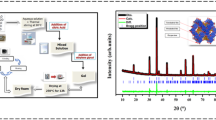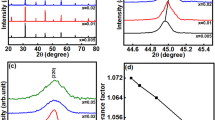Abstract
In this research work, we have prepared lithium lead silicate glasses with varying concentrations of bismuth by following the melt-quench technique. The prepared samples are investigated by ac conductivity and electric modulus formalisms in the frequency and temperature ranges of 10–1–107 Hz and 433–533 K, respectively. To check the applicability of various charge transport mechanisms in these prepared samples, the experimental data of ac conductivity was fitted with Jonscher’s power law. It was found to be satisfied in the studied range of temperature and frequency. AC conductivity helps to calculate all the parameters viz.; dc conductivity, activation energy, frequency exponent parameter, and the cross over frequency. The value of ac conductivity increases with Bi2O3 concentration up to 30 mol% due to mobile lithium ions and the network modifier BiO6 unit. Thereafter, when the ratio of Bi2O3/Li2O becomes greater than unity, the conductivity values decrease due to the blocking effect of the bismuth ions in the network, forming the BiO3 pyramidal unit. In the current research, the correlated barrier hopping model is found to be suitable for explaining the ac conduction mechanism.










Similar content being viewed by others
Data availability
All the data analyzed in this work is included in this article.
References
V. Prasad, B. Suresh, M. Kostrzewa, Y. Gandhi, A. Ingram, A.S. Sesha Reddy, V. Ravi Kumar, N. Veeraiah, Dielectric dispersion, dipolar relaxation, and a.c. conduction phenomena of NiO doped lead-bismuth silicate glass system. J. Non-Cryst. Solids 500, 460–467 (2018). https://doi.org/10.1016/j.jnoncrysol.2018.09.002
S.P. Singh, B. Karmakar, Bismuth oxide and Bismuth oxide doped glasses for optical and photonic applications, in Bismuth: Characteristics, Production and Applications. Materials Science and Technologies (Nova, Hauppauge, New York, 2012), pp. 229–249. http://cgcri.csircentral.net/1384/1/SPS-Book_Chapter_.pdf
L. Srinivasa Rao, AC conductivity and polarization phenomenon of Li2O-MoO3-B2O3:V2O5 glasses. J. Alloys. Compd. 787, 1280–1289 (2019). https://doi.org/10.1016/j.jallcom.2019.02.122
R. Bala, A. Agrawal, S. Sanghi, S. Gaur, S. Rani, Investigation of third order nonlinear optical parameters and optical limiting behavior of PbO·Bi2O3·Ga2O3 glasses. Appl. Phys. A 128, 1036 (2022). https://doi.org/10.1007/s00339-022-06169-6
E.M. Abou Hussein, A.M. Madbouly, N.A. El-Alaily, Gamma ray interaction of optical, chemical, physical behavior of bismuth silicate glasses and their radiation shielding proficiency using Phy-X/PSD program. J. Non-Cryst. Solids 570, 121021 (2021). https://doi.org/10.1016/j.jnoncrysol.2021.121021
N.M. Bobkova, Properties and structure of bismuth borate glasses (review). Glass Ceram. 72, 360–365 (2016). https://doi.org/10.1007/s10717-016-9790-2
A. Yadav, S. Khasa, A. Hooda, M.S. Dahiya, A. Agarwal, P. Chand, EPR and impedance spectroscopic investigations on lithium bismuth borate glasses containing nickel and vanadium ions. Spectrochim. Acta A 157, 129–137 (2016). https://doi.org/10.1016/j.saa.2015.12.027
I.S. Mustafa, N.A.N. Razali, N.Z.N. Azman, N.Z. Yahaya, M.Z.M. Zaini, N.L. Rusli, M.B. Nizamani, H.M. Kamari, Comprehensive study of electronic polarizability and band gap of B2O3–Bi2O3–ZnO–SiO2 glass network. J. Adv. Dielectr. 7, 1750031 (2017). https://doi.org/10.1142/S2010135X1750031X
S.H. Elazoumi, H.A.A. Sideka, Y.S. Rammah, R. El-Mallawany, M.K. Halimah, K.A. Matoria, M.H.M. Zaida, Effect of PbO on optical properties of tellurite glass. Results Phys. 8, 16–25 (2018). https://doi.org/10.1016/j.rinp.2017.11.010
R. Bala, A. Agarwal, S. Sanghi, S. Khasa, Influence of SiO2 on the structural and dielectric properties ZnO‧Bi2O3‧SiO2 glasses. J. Integr. Sci. Technol. 3(1), 6 (2015). https://www.researchgate.net/publication/310752054_Influence_of_SiO2_on_the_structural_and_dielectric_properties_of_ZnO_Bi2O3_SiO2_glasses
K. Nagao, M. Shigeno, A. Inoue, M. Deguchi, H. Kowada, C. Hotehama, A. Sakuda, M. Tatsumisago, A. Hayashi, Lithium-ion conductivity and crystallization temperature of multicomponenet oxide glass electrolytes. J. Non-Cryst. Solids. 14, 100089 (2022). https://doi.org/10.1016/j.nocx.2022.100089
V. Montouillout, H. Fan, L.D. Campo, S. Ory, A. Rakhmatullin, F. Fayon, M. Malki, Ionic conductivity of lithium borate glasses and local structure probed by high resolution solid-sate NMR. J. Non-Cryst. Solids 484, 57–64 (2018). https://doi.org/10.1016/j.jnoncrysol.2018.01.020
B. Suresh, M. Srinivasa Reddy, J. Ashok, A.S. Sesha Reddy, P. Venkateswara Rao, V. Ravi Kumar, N. Veeraiah, Enhancement of orange emission of Co2+ ions with Bi3+ ions in lead silicate glasses. J. Lumin. 172, 47–52 (2016). https://doi.org/10.1016/j.jlumin.2015.11.018
Y. Lee, J.H. Lee, S.H. Honga, Y. Park, Li-ion conductivity in Li2O–B2O3–V2O5 glass system. Solid State Ion. 175(1–4), 687–690 (2004). https://doi.org/10.1016/j.ssi.2004.08.024
Y.B. Saddeek, G.Y. Mohamed, H.S. Hassan, A.M.A. Mostafa, G. Abd elfadeel, Effect of gamma irradiation on the FTIR of cement kiln dust–bismuth borate glasses. J. Non-Cryst. Solids 419, 110–117 (2015). https://doi.org/10.1016/j.jnoncrysol.2015.03.021
S. Rani, S. Sanghi, N. Ahlawat, A. Agarwal, Influence of Bi2O3 on thermal, structural and dielectric properties of lithium zinc bismuth borate glasses. J. Alloys Comp. 597, 110–118 (2014). https://doi.org/10.1016/j.jallcom.2014.01.211
S. Rani, S. Sanghi, N. Ahlawat, A. Agarwal, Influence of Bi2O3 on physical, electrical and thermal properties of Li2O·ZnO·Bi2O3·SiO2 glasses. J. Alloys Comp. 619, 659–666 (2015). https://doi.org/10.1016/j.jallcom.2014.09.029
S. Bale, S. Rahman, Glass structure and transport properties of Li2O containing zinc bismuthate glasses. Opt. Mater. 31, 333–337 (2008). https://doi.org/10.1016/j.optmat.2008.05.007
S. Bale, S. Rahman, A.M. Awasthi, V. Sathe, Role of Bi2O3 content on physical, optical and vibrational studies in Bi2O3–ZnO–B2O3 glasses. J. Alloys Compd. 460, 699–703 (2008). https://doi.org/10.1016/j.jallcom.2007.06.090
S. Bale, S. Rahman, Optical absorption and EPR studies on (70–x)Bi2O3–xLi2O–30(ZnO–B2O3)(0 ⩽ x ⩽ 20)glasses. J. Non Cryst. Solids 355, 2127–2133 (2009). https://doi.org/10.1016/j.jnoncrysol.2009.06.039
S. Bale, N. Srinivasa Rao, S. Rahman, Spectroscopic studies of Bi2O3–Li2O–ZnO–B2O3 glasses. Solid State Sci. 10, 326–331 (2008). https://doi.org/10.1016/j.solidstatesciences.2007.09.017
S. Bale, M. Purnima, Ch. Srinivasu, S. Rahman, Vibrational spectra and structure of bismuth based quaternary glasses. J. Alloys Compd. 457, 545–548 (2008). https://doi.org/10.1016/j.jallcom.2007.03.100
S. Chauhan, R. Bala, S. Rani, S. Gaur, Investigation of structural and optical properties of lithium lead-bismuth silicate glasses. J. Mater Sci: Mater Electron 33(15), 12371–12383 (2022). https://doi.org/10.1007/s10854-022-08194-w
B. Eraiah, Electronic-ionic conductivity of lithium Vanado-phosphate glasses. Mapana J. Sci. 14(1), 9–14 (2015). https://doi.org/10.12723/mjs.32.2
Y.H. Rim, M. Kim, C.G. Baek, Y.S. Yang, Effect of Li content in ion conductivity of lithium silicate glasses. J. Alloy. Comp. 827, 154253 (2020). https://doi.org/10.1016/j.jallcom.2020.154253
S.K. Deshpande, V.K. Shrikhande, M.S. Jogad, P.S. Goyal, G.P. Kothiyal, Conductivity studies of lithium zinc silicate glasses with varying lithium contents. Bull. Mater. Sci. 30, 497–502 (2007). https://doi.org/10.1007/s12034-007-0078-6
S. Chauhan, R. Bala, S. Gaur, S. Rani, Effect of Bi2O3 on structural and optical properties of Li2O·PbO·Bi2O3·B2O3 glasses. J. Mater Sci: Mater Electron 33(15), 22835–22850 (2022). https://doi.org/10.1007/s10854-022-08194-w
A. Yadav, M.S. Dahiya, P. Narwal, A. Hooda, A. Agarwal, S. Khasa, Electrical characterization of lithium bismuth borate glasses containing cobalt/vanadium ions. Solid State Ion. 312, 21–31 (2014). https://doi.org/10.1016/j.ssi.2017.10.006
T. Annapurna, M. Kostrzewa, A.S. Sesha Reddy, A. Ingram, J. Ashok, V. Ravi Kumar, N. Veeraiah, Polaronic conduction and dielectric relaxation dynamics in V2O5 added lead bismuth silicate glass system. J. Non-Cryst. Solids 528, 119746 (2020). https://doi.org/10.1016/j.jnoncrysol.2019.119746
K.S. Rao, D.M. Prasad, P.M. Krishna, B.H. Bindu, K. Suneetha, Frequency and temperature dependence of electrical properties of barium and gadolinium substituted SrBi2Nb2O9 ceramics. J. Mater. Sci. 42, 7363–7374 (2007). https://doi.org/10.1007/s10853-007-1555-4
A.R. James, S. Balaji, S.B. Krupanidhi, Impedance-fatigue correlated studies on SrBi2Ta2O9. Mater. Sci. Eng. B 64(3), 149–156 (1999). https://doi.org/10.1016/S0921-5107(99)00039-2
E.M. Abou Hussein, T.D. Abd Elaziz, N.A. El Alaily, Effect of gamma radiation on some optical and electrical properties of lithium bismuth silicate glasses. J. Mater. Sci. Mater. Electron. 30, 12054–12064 (2019). https://doi.org/10.1007/s10854-019-01563-y
S. Sindhu, S. Sanghi, A. Agarwal, V.P. Seth, N. Kishore, Effect of Bi2O3 content on the optical band gap, density and electrical conductivity of MO·Bi2O3·B2O3 (M = Ba, Sr) glasses. Mater. Chem. Phys. 90, 83–89 (2005). https://doi.org/10.1016/j.matchemphys.2004.10.013
M.M. El-Desoky, Dielectric Behaviour And Ac Conductivity Of Sodium Borate Glass Containing CoO. J. Phys. Chem. Solids 59, 1659–1666 (1998). https://doi.org/10.1016/S0022-3697(97)00212-6
R. Punia, R.S. Kundu, M. Dult, S. Murugavel, N. Kishore, Temperature and frequency dependent conductivity of bismuth zinc vanadate semiconducting glassy system. J. Appl. Phys. 112, 083701 (2012). https://doi.org/10.1063/1.4759356
S. Dahiya, R. Punia, A. Singh, A.S. Maan, S. Murugavel, DC conduction and electric modulus Formulation of lithium doped bismuth zinc vanadate semiconducting glassy system. J. Am. Ceram. Soc. 98(9), 2776–2783 (2015). https://doi.org/10.1111/jace.13661
A.K. Jonscher, Dielectric relaxation in solids. J. Phys. D Appl. Phys. 32(14), R57 (1999). https://doi.org/10.1088/0022-3727/32/14/201
M. Dult, R.S. Kundu, S. Murugavel, R. Punia, N. Kishore, Conduction mechanism in bismuth silicate glasses containing titanium. Phys. B Condens. Matter 452, 102–107 (2014). https://doi.org/10.1016/j.physb.2014.07.004
H. Jain, J.N. Mundy, Analysis of ac conductivity of glasses by a power law relationship. J. Non-Cryst. Solids 91, 315–323 (1987). https://doi.org/10.1016/S0022-3093(87)80342-3
S.R. Elliot, A.c. conduction in amorphous chalcogenide and pnictide semiconductors. Adv. Phys. 36, 135–217 (1987). https://doi.org/10.1080/00018738700101971
N.F. Mott, E.A. Davis, Disordered Materials: Electronic processes in Non-Crystalline Materials, vol. 207, 2nd edn (Clarendon, Oxford University Press, New York, 1979), p. 4436. https://doi.org/10.1126/science.207.4436.1196.b
I.G. Austin, N.F. Mott, Polarons in crystalline and non-crystalline materials. Adv. Phys. 18, 41–102 (1969). https://doi.org/10.1080/00018736900101267
S.R. Elliot, Temperature dependence of a.c. conductivity of chalcogenide glasses. Philos. Mag. B 37, 553–560 (1978). https://doi.org/10.1080/01418637808226448
S. Dahiya, R. Punia, S. Murugavel, A.S. Maan, Conductivity and modulus formulation in lithium modified bismuth zinc borate glasses. Solid State Sci. 55, 98–105 (2016). https://doi.org/10.1016/j.solidstatesciences.2016.02.013
R. Bala, A. Aggrawal, S. Sanghi, Sanjay, Electrical characterization and dielectric behavior of PbO·Bi2O3·Ga2O3 glasses. AIP Conf. Proc. 2142, 070032 (2019). https://doi.org/10.1063/1.5122424
R. Punia, R.S. Kundu, S. Murugavel, N. Kishore, Hopping conduction in bismuth modified zinc vanadate glasses: an applicability of Mott’s model. J. Appl. Phys. 112, 113716 (2012). https://doi.org/10.1063/1.4768898
A. Dutta, T.P. Sinha, P. Jeno, S. Adak, Ac conductivity and dielectric relaxation in ionically conducting soda–lime–silicate glasses. J. Non-Cryst. Solids 354(33), 3952–3957 (2008). https://doi.org/10.1016/j.jnoncrysol.2008.05.028
S.W. Martin, C.A. Angell, Dc and ac conductivity in wide composition range Li2O P2O5 glasses. J. Non-Cryst. Solids 83, 185–207 (1986). https://doi.org/10.1016/0022-3093(86)90067-0
R. Bergman, General susceptibility functions for relaxations in disordered systems. J. Appl. Phys. 88, 1356 (2000). https://doi.org/10.1063/1.373824
R.M.M. Morsi, S. Ibrahim, S.A. Naf, M.M. Morsi, Effect of alkaline earth metal oxides on the dielectric, structural and physico-chemical properties of lithium–zinc–lead-borates. J. Mater. Sci. Mater. Electron. 27, 4147–4156 (2016). https://doi.org/10.1007/s10854-016-4276-0
M.B. Hossen, A.K.M.A. Hossain, Complex impedance and electric modulus studies of magnetic ceramic Ni0.27Cu0.10Zn0.63Fe2O4. J. Adv. Ceram. 4(3), 217–225 (2015). https://doi.org/10.1007/s40145-015-0152-2
L.F. Maia, A.C.M. Rodrigues, Electrical conductivity and relaxation frequency of lithium borosilicate glasses. Solid State Ion. 168, 87–92 (2004). https://doi.org/10.1016/j.ssi.2004.02.016
Acknowledgements
The authors are thankful to GJUST, Hisar for providing the broadband dielectric/impedance spectrometer novocontrol technology for dielectric measurements.
Author information
Authors and Affiliations
Contributions
SC conceptualization, investigation, methodology, writing—original draft. RB supervision, writing—review and editing. SG methodology, writing—review and editing, DS writing—review and editing, SR data curation. RP formal analysis.
Corresponding author
Ethics declarations
Conflict of interest
The authors have no conflicts of interest for declaration.
Ethic statement
The contents of our research paper “Study of AC conductivity and dielectric relaxation in Bi2O3 modified lithium lead silicate glasses” are new and we have synthesized these glasses using melt-quenching technique The glasses have been found to have good electrical properties and can be utilized as potential candidate for solid-state batteries or supercapacitors. It is certified that the work is completely original and has not been published/submitted for publication elsewhere. We will follow all the norms of the publication, such as copyrights etc.
Additional information
Publisher's Note
Springer Nature remains neutral with regard to jurisdictional claims in published maps and institutional affiliations.
Rights and permissions
Springer Nature or its licensor (e.g. a society or other partner) holds exclusive rights to this article under a publishing agreement with the author(s) or other rightsholder(s); author self-archiving of the accepted manuscript version of this article is solely governed by the terms of such publishing agreement and applicable law.
About this article
Cite this article
Chauhan, S., Bala, R., Gaur, S. et al. Study of AC conductivity and dielectric relaxation in Bi2O3 modified lithium lead silicate glasses. Appl. Phys. A 129, 521 (2023). https://doi.org/10.1007/s00339-023-06805-9
Received:
Accepted:
Published:
DOI: https://doi.org/10.1007/s00339-023-06805-9




